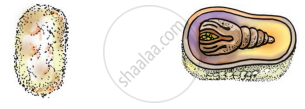Advertisements
Advertisements
Question
Describe the life history of the silk moth with the help of figures from various stages.
Solution
The female silk moth lays eggs. When an egg hatches, a tiny caterpillar crawls out. This is the silkworm or larva. The silkworm feeds on mulberry leaves and grows. When it is ready to enter the next stage in its life cycle, it first weaves a net to hold itself. It then secretes a fibre made of proteins, which hardens on exposure to air. This is the silk fibre. It covers itself completely with this fibre, to form a cocoon. At this stage, the larva is called a pupa. The pupa grows and changes inside the cocoon. A few weeks later, the cocoon opens and an adult moth comes out.


APPEARS IN
RELATED QUESTIONS
Write about Ahimsa Silk.
Which of the following is not a type of silk?
The term sericulture is used for
Reeling of silk is
Some words related to silk are jumbled up. Write them in their correct form.
TURECULRISE
Some words related to silk are jumbled up. Write them in their correct form.
BELMURRY
Steps for the production of silk are given below in a jumbled order. Arrange them in their proper sequence.
- Eggs are warmed to a suitable temperature for the larvae to hatch from eggs.
- Fibres are taken out from the cocoon.
- After 25 to 30 days, the caterpillars stop eating and start spinning cocoons.
- The larvae/caterpillars or silkworms are kept in clean trays along with freshly chopped mulberry leaves.
- Female silk moths lay eggs.
- Cocoons are kept under the sun or boiled in water.
Paheli went to the market to buy sarees for her mother. She took out a thread from the edge of the two sarees shown by the shopkeeper and burnt them. One thread burnt with the smell of burning hair and the other burnt with the smell of burning paper. Which thread is from a pure cotton saree and which one from a pure silk saree? Give a reason for your answer.
______ are boiled to get the silk.
The production of silk is called ______.
